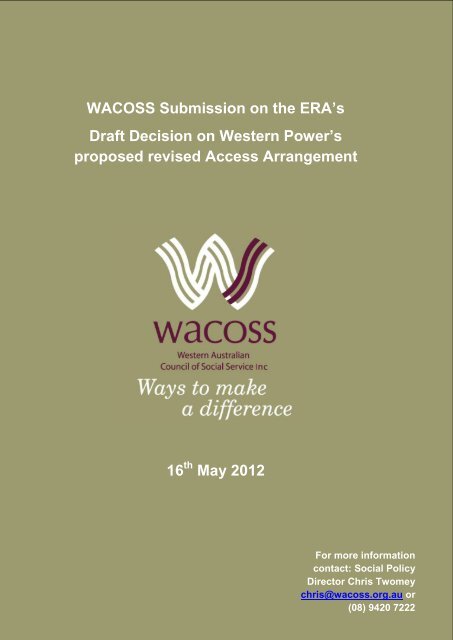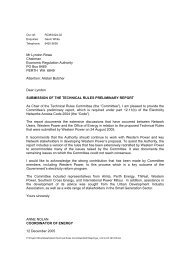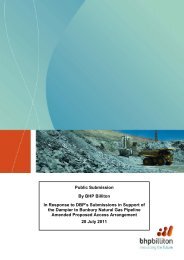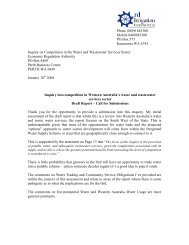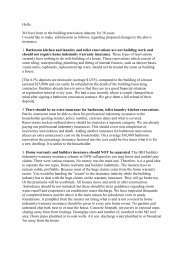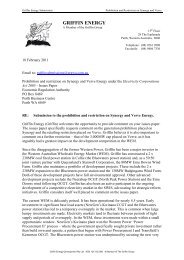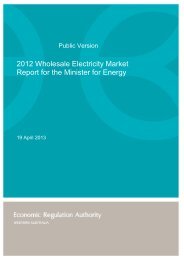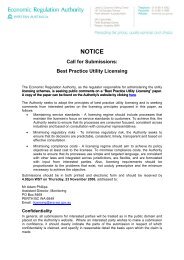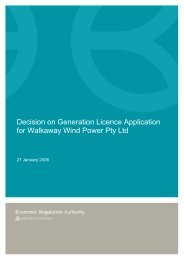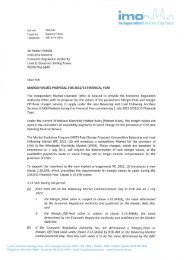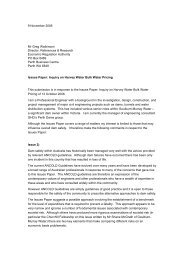Western Power Network Pricing - ERA Economic Regulation ...
Western Power Network Pricing - ERA Economic Regulation ...
Western Power Network Pricing - ERA Economic Regulation ...
Create successful ePaper yourself
Turn your PDF publications into a flip-book with our unique Google optimized e-Paper software.
WACOSS Submission on the <strong>ERA</strong>’s<br />
Draft Decision on <strong>Western</strong> <strong>Power</strong>’s<br />
proposed revised Access Arrangement<br />
16 th May 2012<br />
For more information<br />
contact: Social Policy<br />
Director Chris Twomey<br />
chris@wacoss.org.au or<br />
(08) 9420 7222
Contents<br />
Glossary ................................................................................................................................................... 3<br />
Executive summary ................................................................................................................................. 4<br />
Introduction ............................................................................................................................................ 6<br />
Introduction ............................................................................................................................................ 6<br />
Capital expenditure ................................................................................................................................. 9<br />
Operating expenditure .......................................................................................................................... 11<br />
Rate of return ........................................................................................................................................ 14<br />
Deferred revenue .................................................................................................................................. 17<br />
Service standards .................................................................................................................................. 19<br />
Tariff equalisation contribution ............................................................................................................ 21<br />
Tariff design .......................................................................................................................................... 23<br />
2
Glossary<br />
AA3 Access Arrangement Period 3<br />
AWCC<br />
Capex<br />
DSM<br />
ENAC<br />
<strong>ERA</strong><br />
GBA<br />
IT<br />
Opex<br />
LFAS<br />
RAB<br />
SAIDI<br />
SAIFI<br />
SWIS<br />
TEC<br />
WACC<br />
WACOSS<br />
WEM<br />
average weighted cost of capital<br />
capital expenditure<br />
Demand Side Management<br />
Electricity <strong>Network</strong>s Access Code<br />
<strong>Economic</strong> <strong>Regulation</strong> Authority (The Authority)<br />
Geoff Brown and Associates (technical report to the <strong>Economic</strong> <strong>Regulation</strong> Authority)<br />
Information technology<br />
operating expenditure<br />
Load Following Ancillary Services<br />
regulated asset base<br />
System average interruption duration index<br />
System average interruption frequency index<br />
South west interconnected system<br />
Tariff equalisation contribution<br />
Weighted average cost of capital<br />
<strong>Western</strong> Australian Council of Social Service (The Council)<br />
Wholesale Electricity Market (WA)<br />
3
Executive summary<br />
The <strong>Western</strong> Australian Council of Social Service (the Council) is vitally interested in the work of the<br />
<strong>Economic</strong> <strong>Regulation</strong> Authority (the Authority) on electricity distribution pricing issues because of its<br />
impact on the affordability of electricity for <strong>Western</strong> Australian residents.<br />
<strong>Western</strong> <strong>Power</strong>’s proposal for the third access arrangement period starting in July 2012 would have<br />
resulted in price shocks and imposed genuine hardship on electricity users. The Authority’s draft<br />
decision reduces <strong>Western</strong> <strong>Power</strong>’s revenue cap proposal considerably, but the Council considers that<br />
the reduction is justified in light of the findings of the Geoff Brown and Associates report and the<br />
Authority’s analysis. The extent of the reduction in the Authority’s Draft Decision compared to<br />
<strong>Western</strong> <strong>Power</strong>’s proposal does not in itself suggest any aspect of the Draft Decision is wrong.<br />
<strong>Western</strong> <strong>Power</strong> has exhibited a history of over-estimating future demand and pulling forward<br />
projects, and has arguably done so again in its proposal for the third access arrangement period. It<br />
has also exhibited inefficiency in the governance of its capital works programs. On this basis, the<br />
Council supports the reductions proposed by the Authority in <strong>Western</strong> <strong>Power</strong>’s capital works<br />
program. Without these reductions, <strong>Western</strong> <strong>Power</strong> would arguably not have sufficient incentive to<br />
improve its performance.<br />
In relation to its proposed operating expenditure, <strong>Western</strong> <strong>Power</strong> is significantly above the average<br />
level of interstate distributors. This is true even though <strong>Western</strong> <strong>Power</strong> has been compared with the<br />
State averages, which would tend to advantage a more urban-based distributor such as <strong>Western</strong><br />
<strong>Power</strong>. The Council supports the Authority’s decisions to reduce <strong>Western</strong> <strong>Power</strong>’s operating<br />
expenditure proposals and to set an operating expenditure efficiency dividend. The Council<br />
considers that a 3 per cent operating expenditure efficiency dividend is appropriate as it will drive<br />
<strong>Western</strong> <strong>Power</strong> over the course of the third access arrangement period to near the average of the<br />
current benchmark performance for the interstate comparator group. <strong>Western</strong> <strong>Power</strong> needs this<br />
incentive in order to move towards average benchmark performance levels.<br />
The Council considers <strong>Western</strong> <strong>Power</strong>’s credit rating should be set at A+ or AA based on a<br />
comparator group of government energy networks and with Synergy’s credit rating. <strong>Western</strong><br />
<strong>Power</strong>’s business model is inherently low risk, and the Electricity <strong>Network</strong>s Access Code provides a<br />
number of features such as pass-through arrangements for changes in underlying costs that further<br />
insulate <strong>Western</strong> <strong>Power</strong> from risk. The Council considers it would be useful as an input for the<br />
Authority’s consideration to have a credit rating of <strong>Western</strong> <strong>Power</strong> undertaken by an independent<br />
credit rating agency.<br />
The Council considers the revenue deferred due to the change in the treatment of capital<br />
contributions should be recovered over the useful life of the assets. This approach is consistent with<br />
the general approach to recovery of capital and avoids the potential for price shocks in final user<br />
tariffs, or price shocks that might arise from acceleration of the wooden pole replacement program<br />
or changes in side constraints.<br />
The Council supports the move to minimum service standards coupled with incentive targets. The<br />
Council considers that to improve targeting of worst performing feeders, <strong>Western</strong> <strong>Power</strong> should<br />
4
publish data on the performance of the worst 10 or 15 per cent of feeders in each of the categories<br />
of CBD, urban, rural short, and rural long feeder categories.<br />
The Council considers the Authority’s final decision should contain a mechanism to match the<br />
estimated tariff equalisation contribution with the actual tariff equalisation contribution when the<br />
actual tariff equalisation contribution is gazetted by the Government. As a policy matter the Council<br />
considers the tariff equalisation contribution should be removed because of the distortion it imposes<br />
on electricity use both within and outside <strong>Western</strong> <strong>Power</strong>’s network area. The contribution should<br />
be funded by government from consolidated revenue and directed as a direct payment to those<br />
users outside <strong>Western</strong> <strong>Power</strong>’s area that are most in need.<br />
The Council considers that the side constraints on changes in relative tariffs among tariff class es<br />
should be set at a real rate of change of 1 per cent rather than the 2 per cent proposed by <strong>Western</strong><br />
<strong>Power</strong>. <strong>Western</strong> <strong>Power</strong> has not demonstrated that current tariff levels contain cross-subsidies or<br />
are otherwise inappropriate. Permitting 2 per cent real rebalancing of tariffs might result in the<br />
movement of costs to those customer classes where users are less able to avoid tariff increases in<br />
the short term. This would result in less efficient tariff structures.<br />
5
Introduction<br />
The <strong>Western</strong> Australian Council of Social Service (the Council) is a not-for-profit, member based<br />
organisation and the peak body for the social service sector in WA. Since 1956, the Council has been<br />
developing and strengthening the non-government community services sector's capacity to assist all<br />
<strong>Western</strong> Australians. At the heart of its activities, lies the belief that the mark of a civilised<br />
community is the support and help it gives to those most in need. The Council and its members are<br />
committed to a socially just and sustainable society for all West Australians. We share a vision of an<br />
inclusive, just and equitable society now and in the future.<br />
As electricity is an essential service, the Council is vitally interested in ensuring it is affordable.<br />
Transmission and distribution tariffs are a key element of final electricity prices for residential<br />
customers. This submission responds to the Draft Decision by the <strong>Economic</strong> <strong>Regulation</strong> Authority on<br />
<strong>Western</strong> <strong>Power</strong>’s Proposed Revised Access Arrangement for the period from July 2012 to June 2017<br />
(AA3 Proposal).<br />
The Council is generally supportive of the Authority’s Draft Decision. The Council also supports the<br />
savings identified in the Authority’s Technical Review of <strong>Western</strong> <strong>Power</strong>’s Proposal by Geoff Brown<br />
and Associates (GBA). Having said that, the Council considers that there are some opportunities for<br />
further cuts to the revenue cap that would provide stronger incentives for <strong>Western</strong> <strong>Power</strong> to<br />
become more efficient but would not imperil its ability to provide services at an acceptable<br />
standard.<br />
The Council considers that <strong>Western</strong> <strong>Power</strong>’s proposal submitted in September did not meet the<br />
criteria for acceptance under the Electricity <strong>Network</strong>s Access Code (ENAC). <strong>Western</strong> <strong>Power</strong>’s AA3<br />
proposal would have imposed very real hardship on residential electricity consumers. The<br />
contemplated real increases in transmission and distribution tariffs of 16.4 per cent in the first year,<br />
and thereafter over 11 per cent in real terms, if accepted, would have led to large rises in final<br />
electricity tariffs.<br />
Graph 1 below shows the impact in real terms of <strong>Western</strong> <strong>Power</strong>’s proposal compared with the<br />
Authority’s Draft Decision on transmission and distribution tariffs for a notional $1000 level of<br />
expenditure in the current 2011-12 financial year. Graph 2 below shows the impact in real terms on<br />
final residential tariffs of <strong>Western</strong> <strong>Power</strong>’s proposal compared with the Authority’s Draft Decision.<br />
The cumulative real increase in <strong>Western</strong> <strong>Power</strong>’s transmission and distribution tariffs would have<br />
been almost 79 per cent, while the cumulative real increase in final residential tariffs would have<br />
been in the order of 31 per cent. 1<br />
1 Assuming transmission and distribution tariffs are 40 per cent of final residential electricity bills.<br />
6
Graph 1: Projected real changes in transmission and distribution tariffs over the AA3 period<br />
Graph 2: Projected real changes in final residential tariffs over the AA3 period<br />
Note: Based on the assumption that <strong>Western</strong> <strong>Power</strong>’s transmission and distribution tariffs equate to 40 per cent of final<br />
residential tariffs.<br />
These tariff increases would, if implemented, result in a very substantial price shock for residential<br />
electricity users. The Council would be very concerned about any move in the Authority’s final<br />
decision back towards <strong>Western</strong> <strong>Power</strong>’s AA3 proposal.<br />
7
As an associated point, the Council considers that while the Draft Decision cuts <strong>Western</strong> <strong>Power</strong>’s<br />
revenue cap from the revenue proposed in its AA3 proposal, this reflects that <strong>Western</strong> <strong>Power</strong>’s<br />
starting point in its AA3 proposal was too high. In itself the reduction proposed in the Draft Decision<br />
to the revenue cap compared with <strong>Western</strong> <strong>Power</strong>’s AA3 proposal does not suggest the Draft<br />
Decision is wrong.<br />
This submission comments on the following matters considered in the Draft Decision:<br />
<br />
<br />
<br />
<br />
<br />
<br />
<br />
Capital expenditure;<br />
Operating expenditure;<br />
The rate of return;<br />
Deferred revenue;<br />
Service standards;<br />
The tariff equalisation contribution; and<br />
Tariff design.<br />
8
Capital expenditure<br />
The Council supports the Authority’s decision to reduce <strong>Western</strong> <strong>Power</strong>’s proposed capital<br />
expenditure (capex) budget over the AA3 period. The reductions are in the order of $710m over the<br />
AA3 period.<br />
The Authority noted that it was being cautious in considering <strong>Western</strong> <strong>Power</strong>’s required level of<br />
capex. The Council support the Authority’s reasons for being conservative in approving <strong>Western</strong><br />
<strong>Power</strong>’s capex budget since:<br />
<br />
<br />
<br />
It appears <strong>Western</strong> <strong>Power</strong> in the AA1 and AA2 periods has consistently over-estimated its<br />
capex requirements, and in particular because it is not necessarily accurate in estimating the<br />
costs of new projects or in estimating future growth in demand;<br />
It appears from the GBA report that <strong>Western</strong> <strong>Power</strong> appears to have over-estimated its<br />
capex requirements substantially during the AA3 period; 2<br />
These over-estimates result in revenue caps higher than they should be. As noted in the<br />
Draft Decision, users paid more than necessary during both the AA1 and the AA2 periods<br />
due to these over-estimates. The estimation techniques are within <strong>Western</strong> <strong>Power</strong>’s control<br />
so it is appropriate to carefully scrutinise them and take a conservative approach in order to<br />
sharpen <strong>Western</strong> <strong>Power</strong>’s incentives to better forecast and plan its capex program.<br />
As a more general point, the Council considers that the risks in awarding too much capex in the AA3<br />
period are greater than risks of awarding <strong>Western</strong> <strong>Power</strong> too little capex. Awarding <strong>Western</strong> <strong>Power</strong><br />
too much capex will blunt its incentives to minimise expenditure on specific projects, to defer new<br />
investments or replacement capex until the appropriate time, or to implement cost savings in<br />
relation to corporate costs. If too little capex were to be awarded, <strong>Western</strong> <strong>Power</strong> may either have<br />
to defer projects to the AA4 period (i.e. no more than five years), or, if it incurs expenditure during<br />
the AA3 period, lose the return on that expenditure for a short period. 3 The risks are clearly greater<br />
in awarding too much capex during the AA3 than too little.<br />
Given the history of inefficient capital spending during the AA1 and AA2 periods, and <strong>Western</strong><br />
<strong>Power</strong>’s lack of progress in improving efficiency (noted by the Authority in the Draft Decision), there<br />
is a very real risk that if <strong>Western</strong> <strong>Power</strong> is awarded too much capex it will act inefficiently in the<br />
management of its capex budget. The Draft Decision noted significant evidence of inefficiency in risk<br />
management and the targeting and management of the capex budget. For example, the Authority<br />
excluded $261m at end of AA1 due to weaknesses in <strong>Western</strong> <strong>Power</strong>’s “planning, design and<br />
governance of investment expenditure and inefficiencies in cost estimation processes”. 4 The GBA<br />
2 GBA, chapters 6-9.<br />
3 It may not even lose the return for a short period if it can justify the capex to the Authority or otherwise justify<br />
its pass-through. The Council notes that special arrangements are in place to bring forward capex on wooden<br />
pole replacement.<br />
4 <strong>ERA</strong> Draft Decision p. 9, paragraph 45.<br />
9
eport highlighted major capex over-estimates in <strong>Western</strong> <strong>Power</strong>’s AA3 proposal, and recommended<br />
the exclusion of $710m or around 15 per cent of the capex sought by <strong>Western</strong> <strong>Power</strong>. <strong>Western</strong><br />
<strong>Power</strong>’s over-estimates arose mainly by over-estimating the strength of demand during the AA3, and<br />
thus bringing forward projects that could be deferred to the AA4 period.<br />
The Council also considers it would be useful for the Authority to benchmark the efficiency of capital<br />
projects against interstate comparators to provide users and other interested parties within insights<br />
into the efficiency of <strong>Western</strong> <strong>Power</strong>’s capital spending. For example, <strong>Western</strong> <strong>Power</strong> could publish<br />
data on the cost of construction per kilometre of line in greenfields and brownfields situations for a<br />
range of voltages. This would help users to comment on <strong>Western</strong> <strong>Power</strong>’s performance at the next<br />
access arrangement period. At present, GBA’s technical commentary in relation to capex mainly<br />
focuses on an analysis of <strong>Western</strong> <strong>Power</strong>’s capital governance processes, evaluation of the new<br />
facilities investment test for particular projects, and an assessment of whether projected demand<br />
growth over the access arrangement period supports proposed projects. There is only very limited<br />
benchmarking in the GBA report, with brief use in chapter 6 in critiquing inventory levels.<br />
The Council supports the Authority’s approach to <strong>Western</strong> <strong>Power</strong>’s wooden pole replacement<br />
program of permitting <strong>Western</strong> <strong>Power</strong> to recover any increased expenditure on its program from the<br />
time of expenditure rather than from the start of the AA4 period. Having said that, the Authority’s<br />
approach does raise the prospect that if <strong>Western</strong> <strong>Power</strong> accelerates its wooden pole replacement<br />
program, as may be expected given the EnergySafety directive, <strong>Western</strong> <strong>Power</strong>’s revenue cap may<br />
grow faster than projected in the Draft Decision. This would have implications for affordability and<br />
for price shocks. The Council has made suggestions for managing the risk of price shocks in the<br />
sections below dealing with deferred revenue and tariff design.<br />
The Council specifically support the Authority’s decision to disallow the $261m excluded at the start<br />
of the AA2 period on the basis that this approach incentivises <strong>Western</strong> <strong>Power</strong> to improve its capex<br />
governance processes. This is something within <strong>Western</strong> <strong>Power</strong>’s ability to do.<br />
The Council considers there is scope for a capex efficiency dividend over the period of the AA3<br />
access arrangement similar to the operating expenditure (opex) efficiency dividend proposed in the<br />
Draft Decision. A capex dividend is justified by project management efficiencies and new<br />
technological developments that offer the very real prospect of substantial savings in particular<br />
projects. For example, metal cross-arms on poles can reduce replacement capex over time,<br />
horizontal drilling techniques can save on the cost of laying underground lines particularly in the<br />
area of surface reinstatement, better quality global positioning systems data and field tracking can<br />
assist in quicker location of assets for replacement purposes, and greater mechanisation can speed<br />
up pole placement. <strong>Western</strong> <strong>Power</strong> needs incentives to seek out these savings. The enhanced risk<br />
management systems that <strong>Western</strong> <strong>Power</strong> is planning to introduce as part of its IT program will help<br />
<strong>Western</strong> <strong>Power</strong> to improve the efficiency of its capex spending. Without a capex efficiency dividend<br />
<strong>Western</strong> <strong>Power</strong> will have little incentive to pursue more efficient means of executing capital<br />
projects.<br />
Recommendation 1: Require a capex efficiency dividend for <strong>Western</strong> <strong>Power</strong>.<br />
10
Operating expenditure<br />
The Council supports the position taken by the Authority in the Draft Decision to reduce <strong>Western</strong><br />
<strong>Power</strong>’s AA3 opex allowance in its revenue proposal on the basis of the recommendations of its<br />
technical consultant, GBA. The reductions are in the range of $520m over the AA3 period.<br />
The Authority presents the results of a benchmarking study comparing <strong>Western</strong> <strong>Power</strong>’s opex<br />
efficiency performance against the State averages for five other jurisdictions (Queensland, NSW,<br />
Victoria, South Australia, and Tasmania). 5 GBA uses three benchmarks:<br />
<br />
<br />
Opex/km line;<br />
Opex/customer; and<br />
Opex/RAB (regulated asset base). 6<br />
The Council considers that these benchmarks are well chosen. While benchmarking has inherent<br />
limitations as noted by GBA, the benchmarks selected by GBA are simple, transparent, clear, and<br />
capable of normalisation. More importantly, they relate to key cost drivers within electricity<br />
networks. The Opex/Km Line benchmark is an appropriate benchmark as line length represents the<br />
size of the network. The size of the network is a direct influence on the size of the maintenance<br />
effort. The Opex/Customer benchmark is an appropriate benchmark as customer numbers have a<br />
direct effect on metering, connections, customer services and billing costs. The Opex/RAB<br />
benchmark is an appropriate benchmark as the RAB is the most immediate and relevant proxy for<br />
the replacement cost of the network and is a measure of the size of an electricity network. The<br />
physical size of the network drives the number of operations and maintenance activities required.<br />
Accordingly, the Council considers the opex benchmarks should be considered closely in setting the<br />
opex allowance and in determining the scope for efficiency savings over time. It is appropriate to<br />
place reasonable weight on the benchmarks and to undertake a normalisation process when<br />
comparing <strong>Western</strong> <strong>Power</strong>’s network to the interstate comparator group.<br />
When considering the results of the benchmarking it is worthwhile to note that the benchmarks<br />
would tend to favour <strong>Western</strong> <strong>Power</strong> because <strong>Western</strong> <strong>Power</strong> is compared with State average<br />
performance in these three benchmarks in each of the five comparator States. 7 The State averages<br />
include widely dispersed country areas (particularly in Queensland and NSW) where benchmark<br />
performance is reduced by the distances that service crews have to travel to maintain the network.<br />
These travel costs drive up opex and reduce performance against the benchmarks considerably.<br />
Within <strong>Western</strong> Australia, the extent of this tendency could be verified by comparing <strong>Western</strong><br />
<strong>Power</strong>’s performance against Horizon <strong>Power</strong>’s performance.<br />
5 <strong>ERA</strong> Draft Decision, table 11, p. 58.<br />
6 <strong>ERA</strong> Draft Decision, table 11, p. 58.<br />
7 <strong>ERA</strong> Draft Decision, p. 58, table 11.<br />
11
The Council considers that a truer picture of <strong>Western</strong> <strong>Power</strong>’s relative performance would emerge<br />
by comparing it with distribution entities with substantial urban networks, such as Ausgrid and<br />
Endeavour Energy in NSW, Energex in Queensland, ETSA in South Australia, Citipower and United<br />
Energy and Jemena in Victoria, and Aurora in Tasmania. This comparison would be likely to reveal a<br />
relatively poorer performance by <strong>Western</strong> <strong>Power</strong>.<br />
In any event, the Council considers that <strong>Western</strong> <strong>Power</strong>’s performance against the benchmarks<br />
highlight both significant scope for improvement and also the importance of imposing strong<br />
incentives on <strong>Western</strong> <strong>Power</strong> to improve its performance. <strong>Western</strong> <strong>Power</strong>’s history of performance<br />
during AA2 would suggest that simply providing <strong>Western</strong> <strong>Power</strong> with time to improve without<br />
simultaneously placing incentives on it to improve may not lead to improvements. Specifically, the<br />
Council notes that:<br />
<br />
<br />
<br />
The benchmark comparison shows <strong>Western</strong> <strong>Power</strong> is second worst on the opex/km line<br />
benchmark, second worst (and almost worst) on the Opex/Customer benchmark, and the<br />
worst on the Opex/RAB benchmark;<br />
The capex spending on wood pole replacement should provide scope for opex savings – as<br />
the old wood poles are replaced with new assets with inherently lower maintenance costs;<br />
and<br />
Better condition-based risk management and other IT-supported efficiency measures should<br />
provide greater efficiencies. 8<br />
The Council considers that, as a result, it is appropriate to provide strong incentives in the AA3 for<br />
<strong>Western</strong> <strong>Power</strong> to move towards greater efficiency. Accordingly, the Council would argue for the<br />
Final Decision to lift the efficiency dividend from the 2 per cent proposed in the Draft Decision to<br />
3 per cent.<br />
It is worthwhile to examine the impact of a 3 per cent efficiency dividend on <strong>Western</strong> <strong>Power</strong>.<br />
Table 1 presents the impact of a two per cent year-on-year improvement <strong>Western</strong> <strong>Power</strong>’s<br />
performance against the three opex benchmarks. Table 2 presents the impact of the three per cent<br />
year-on-year improvement.<br />
Table 1: Modelling a two percent cumulative opex efficiency improvement ($ real, 2012)<br />
<strong>Western</strong> <strong>Power</strong> performance Opex/Km line Opex/Customer Opex/RAB (%)<br />
for year ending:<br />
2012-13 4417 424 7.1%<br />
2013-14 4329 416 6.9%<br />
2014-15 4242 408 6.8%<br />
2015-16 4157 399 6.6%<br />
2016-17 4074 391 6.5%<br />
Average current performance<br />
in the comparator group<br />
3994 374 5.7%<br />
8 <strong>ERA</strong> Draft Decision, p. 79, paragraph 311.<br />
12
Source: Averages drawn from GBA, p. 115 reproduced at <strong>ERA</strong> Draft Decision, p. 58, table 11. <strong>Western</strong> <strong>Power</strong>’s performance<br />
improved by 2 per cent each year from the performance reported in table 11.<br />
Table 2: Modelling a three percent cumulative opex efficiency improvement ($ real, 2012)<br />
<strong>Western</strong> <strong>Power</strong> performance Opex/Km line Opex/Customer Opex/RAB (%)<br />
for year ending:<br />
2012-13 4372 420 7.0%<br />
2013-14 4241 407 6.8%<br />
2014-15 4113 395 6.6%<br />
2015-16 3990 383 6.4%<br />
2016-17 3870 372 6.2%<br />
Average current performance<br />
in the comparator group<br />
3994 374 5.7%<br />
Source: Averages drawn from GBA p. 115, reproduced at <strong>ERA</strong> Draft Decision, p. 58, table 11. <strong>Western</strong> <strong>Power</strong>’s performance<br />
improved by 3 per cent each year from the performance reported in table 11.<br />
It is clear from table 1 that a two per cent improvement each year will leave <strong>Western</strong> <strong>Power</strong> at the<br />
end of the AA3 period in 2016-17 above the average of the comparator group on all three<br />
benchmarks. For example on the Opex/Km line benchmark, <strong>Western</strong> <strong>Power</strong> will in 2016-17 be at<br />
$4074/km line compared to the current average performance of $3994/km line length.<br />
Table 2 shows that a three per cent efficiency dividend will drive <strong>Western</strong> <strong>Power</strong> to just under the<br />
current average performance for Opex/Km line and Opex/Customer, and still above the average for<br />
Opex/RAB. This suggests that a three per cent efficiency dividend is more appropriate. Even with a<br />
3 per cent annual efficiency improvement, <strong>Western</strong> <strong>Power</strong> would only be approaching the historical<br />
level of efficiency of the comparator group. This historical level of efficiency is in turn drawn from<br />
data as old as 2008, as can be seen from the sources identified in the GBA report. 9 Even if <strong>Western</strong><br />
<strong>Power</strong> catches up to this historical average, it is likely still to be lagging best practice by a margin<br />
given improvements by the comparator group up to the end of the AA3 period in mid-2017.<br />
The Council’s view is that a three per cent efficiency dividend will move <strong>Western</strong> <strong>Power</strong>’s<br />
benchmarked performance closer to the average of the interstate comparisons. A two percent<br />
efficiency dividend would not do enough to drive <strong>Western</strong> <strong>Power</strong> towards the average performance<br />
level, especially as that average is likely to have improved over the period of the AA3 access<br />
arrangement.<br />
Recommendation 2: Require a 3 per cent opex efficiency dividend for <strong>Western</strong> <strong>Power</strong>.<br />
9 GBA, p. 115, sources identified at foot of table 10.2.<br />
13
Rate of return<br />
The Council supports the use of a post-tax weighted average cost of capital (WACC) in determining<br />
the rate of return on <strong>Western</strong> <strong>Power</strong>’s capital base. This approach avoids any windfalls that might<br />
arise from <strong>Western</strong> <strong>Power</strong>’s tax position.<br />
The Council notes that the position in the Draft Decision is that <strong>Western</strong> <strong>Power</strong>’s credit rating should<br />
be A-. The Council considers that <strong>Western</strong> <strong>Power</strong>’s credit rating should be higher, at either A+ or AA.<br />
The Council would support a formal credit rating of <strong>Western</strong> <strong>Power</strong> by an independent, wellrecognised<br />
credit agency as an input for the Authority to determine an appropriate credit rating for<br />
<strong>Western</strong> <strong>Power</strong>.<br />
It is significant that Synergy was rated A+ in 2010 by an independent rating agency. 10 Synergy<br />
achieved this credit rating at a time of market turmoil, in a competitive market with regulated tariffs<br />
set at far below cost, where both its revenues and its costs were subject to much greater volatility<br />
than <strong>Western</strong> <strong>Power</strong>. 11 As a monopoly or near monopoly in the provision of transmission and<br />
distribution services, <strong>Western</strong> <strong>Power</strong>’s revenues are much more predictable than Synergy’s. The<br />
volatility of Synergy’s revenues and costs implies in finance theory a lower credit rating and a higher<br />
level of risk. Under reasonable circumstances, Synergy should be assessed as a riskier proposition<br />
than <strong>Western</strong> <strong>Power</strong>. This indicates <strong>Western</strong> <strong>Power</strong> should be rated with credit rating at least as<br />
high, if not higher, than Synergy’s A+ rating.<br />
The Council supports the use of an appropriate comparator group of power companies to estimate<br />
<strong>Western</strong> <strong>Power</strong>’s credit rating. The Council considers that the most appropriate comparator group<br />
companies are publicly owned energy network companies. This group shares the most<br />
characteristics with <strong>Western</strong> <strong>Power</strong>. The average for this group, drawn from Table 70 in the Draft<br />
Decision, is AA.<br />
In assessing <strong>Western</strong> <strong>Power</strong>’s credit rating, it is notable that under the Electricity <strong>Network</strong>s Access<br />
Code (ENAC), <strong>Western</strong> <strong>Power</strong> has the ability to pass-through unanticipated costs, costs arising from<br />
safety directions, and costs arising from changes in taxes or the regulatory environment. The Draft<br />
Decision notes that:<br />
The price control also includes provision for adjustments to revenues from one access<br />
arrangement period to the next, including provision for adjustments for unforeseen events and<br />
technical rule changes, and adjustments under the investment adjustment mechanism and<br />
capital contributions adjustment mechanism. 12<br />
10 <strong>ERA</strong> Draft Decision p. 174, paragraph 738.<br />
11 The fact that regulated final tariffs for users under 50 MWh per year are below cost somewhat protects<br />
Synergy from competition but only because such tariffs are not profitable. As tariffs move towards competitive<br />
levels Synergy will be exposed to greater competition and volatility in its revenues.<br />
12 <strong>ERA</strong> Draft Decision, p. 34, paragraph 160.<br />
14
Additionally, under the Draft Decision, <strong>Western</strong> <strong>Power</strong> would have the ability to immediately earn a<br />
return on any increased costs arising from acceleration of the wooden pole replacement program.<br />
These arrangements assist in making <strong>Western</strong> <strong>Power</strong>’s revenues more predictable and lower risk.<br />
Recommendation 3: Require an independent credit rating of <strong>Western</strong> <strong>Power</strong>.<br />
<strong>Western</strong> <strong>Power</strong>’s credit rating based on an appropriate comparator group is A+ or AA.<br />
Systemic Efficiency Improvements.<br />
The Council would like to suggest introduction of a further measure to assess a reasonable rate of<br />
return for investment by <strong>Western</strong> <strong>Power</strong> in Future periods.<br />
The Council notes the absence of particular financial incentive in the Average Weighted Cost of<br />
Capital (AWCC) rate of return for <strong>Western</strong> <strong>Power</strong> to invest for future improvement to the technical<br />
efficiency of power services delivery to the domestic customer through investment in Smart Grid<br />
technology. Moreover small domestic customers are currently excluded from the WEM. Providing<br />
an opportunity for customers to participate in the low cost intermittent renewable and overnight<br />
thermal power will address a significant market failure of the WEM. Domestic consumers are<br />
dispersed and generally considered uneconomic for inclusion in commercial Demand Side<br />
Management (DSM) aggregation.<br />
Real time Smart Grid technologies are currently available to enable dispatch on the demand side and<br />
the inclusion of small customers as part of the balancing and Load Following Ancillary Services (LFAS)<br />
function 13 . <strong>Western</strong> <strong>Power</strong> as the regulated network provider and system operator has the<br />
opportunity to address this market failure and provide technology to aggregate and distribute the<br />
benefits of technical efficiency gains to participating consumers. The Council supports the ERM<br />
<strong>Power</strong> submission advocating the inclusion of constrained connection as a severance service 14 and<br />
advocates further for the continued development of Smart Grid technologies with upgradeable<br />
capacity to permit real time system management of consumer loads on an opt in basis.<br />
Whilst acknowledging significant work already done in the area of smart metering and curtailable<br />
loads, the Council would welcome development of a framework to consider financial incentives that<br />
would encourage <strong>Western</strong> <strong>Power</strong> investment to facilitate:<br />
<br />
<br />
Consumer level participation in the in the Ancillary Service Markets (dispatch able real time<br />
system management of consumer level generation or thermal storage etc.)<br />
Increased generator efficiency and decreased line loss through system management of<br />
dispatch able (up and down) consumer load.<br />
13 Cost Benefit Analysis of Smart Metering and Direct Load Control, CRA International Sept 2007 pp 13. Smart<br />
Meter Function 14, Case C appears to provide an enhancement to core functionality 8 in being able to<br />
remotely “Turn on” or “turn off” controlled load at 99% of meters within 1 minute.<br />
14 ERM <strong>Power</strong> Submission to <strong>ERA</strong>, AA3, 2012<br />
15
Availability of intermittent renewable power and power from under loaded thermal<br />
generators for consumer level energy service supply at or near marginal costs 15 (i.e. on<br />
similar terms as available to other market participants).<br />
Harvest of the benefits of low cost overnight use of legacy Verve thermal power units<br />
directly by consumers.<br />
Reduce the competitive position of gas and liquid fuel generation in overnight LFAS market<br />
to promote energy security and conservation of relatively more scarce hydrocarbons.<br />
The potential future cost savings to consumers from participation in provision of LFAS and Spinning<br />
Reserve are not insubstantial 16 . It is reasonable that <strong>Western</strong> <strong>Power</strong> share in a financial incentive<br />
over and above the AWCC for investment that allows the consumer to directly capture (or at least to<br />
compete with other market participants) in improvements to system wide technical performance.<br />
Consumers (through cost reflectivity movement in the A1 tariff) will bear financial risk of both<br />
increased volume of projected load balancing and LFAS (estimated to increase to +/- 90MW in<br />
2011/12) 17 as well potentially increased unit prices for these services in the imminent ancillary<br />
service market. The consumer also bears the risk of a potentially deteriorating financial position of<br />
Verve resulting from the introduction of the ancillary market.<br />
Recommendation 4:That the <strong>ERA</strong> model options for <strong>Western</strong> <strong>Power</strong> to share in financial incentives<br />
for investment promoting technical efficiency improvement in consumer electrical services<br />
delivery.<br />
Recommendation 5:That <strong>Western</strong> <strong>Power</strong> is provided financial incentives to implement<br />
‘upgradable’ smart meters and other technical services to facilitate future consumer participation<br />
in the wholesale and ancillary services market including direct System Management control of<br />
some loads.<br />
15 On Behalf of System Managment, Roam Consulting modelled up to 61.5% curtailment of annual total<br />
production of the estimated 1391 MW of Wind capacity to be installed in the SWIS by 2019-20. At 35%<br />
availability and 10% distribution losses this represents $1,276,520,700 worth of electricity if delivered at the A1<br />
tariff. ROAM 2011<br />
16 Roam Consulting estimates the 2015-16 LFAS requirement to be 125.3 MW. For the purpose of illustration,<br />
if consumers where to consume say 30% of this via controlled loads at low charge (say 8c kW) and this<br />
displaced 80% of this consumption at the A1 tariff (say 26c kW) this would represent nominal saving of<br />
$42,052, 648 pa to SWIS Customers. ((125.3 x 0.3 x 0.8 x 260) - (125.3 x 0.3 x 80)) x 8760 (hours per year).<br />
WACOSS understands that this illustration is a theoretical possibility with a range of system security, regulatory<br />
and consumer behaviour barriers to overcome.<br />
17 Roam Consulting estimate Load Following Ancillary Service requirement of 89MW in 2012 rising to<br />
125.3MW by 2015-16.<br />
16
Deferred revenue<br />
The Draft Decision proposes to permit <strong>Western</strong> <strong>Power</strong> to recover the revenue deferred in<br />
connection with capital contributions at the start of the AA2 period over a ten year period starting<br />
with the AA3 period. 18 The deferral in revenue arose out of a change in the treatment of<br />
contributed assets from the end of AA1 to the start of AA2.<br />
The Draft Decision notes that clause 6.4(c) of the ENAC provides that pricing arrangements should<br />
seek to avoid imposing price shocks.<br />
The Council considers that this deferred revenue should be recouped over the life of the underlying<br />
assets. Ordinarily, returns on capital occur over the useful life of that capital asset 19 . The Authority<br />
takes this approach in relation to the network assets constructed by <strong>Western</strong> <strong>Power</strong>. The<br />
Authority’s approach makes sense for <strong>Western</strong> <strong>Power</strong>’s assets as these assets provide services<br />
continuously over their useful life, and collecting the capital return in the year of construction would<br />
not be feasible. The approach, in other words, is to match the period for repayment of capital to the<br />
useful life of the asset.<br />
The Council considers that there is no good reason to depart from the ordinary practice of<br />
recovering the return on the assets over their useful life (understood to be around 40 years). The<br />
fact these are contributed assets should not change the approach.<br />
The submission from the Office of Energy argued for a short recovery period on the basis that a<br />
longer period might impose possible cash flow problems on <strong>Western</strong> <strong>Power</strong>. However, <strong>Western</strong><br />
<strong>Power</strong> has not provided any evidence to demonstrate it expects to suffer a cash flow problem in<br />
practice that would justify a shorter recovery period than the usual period for recovery of capital. In<br />
this regard, the Council agrees with the Draft Decision’s overall observation that the “price control<br />
provides adequate revenue to meet the forward-looking and efficient costs of providing covered<br />
services”. 20<br />
The Council also considers that:<br />
<br />
<br />
Despite the arguments by <strong>Western</strong> <strong>Power</strong> to the contrary, an early repayment period of<br />
10 years imposes a potential intergenerational debt on current users given the assets being<br />
repaid in the 10 year period will continue to provide services well past 10 years.<br />
There is no strong basis for selecting a 10 year recovery period rather than the useful life of<br />
the relevant assets.<br />
18 The Draft Decision proposes to re-examine the length of the period at the start of AA4 period.<br />
19 The Australian Accounting Standards Board Accounting Standard AASB 116, Property, Plant and Equipment<br />
states that “The depreciable amount of an asset shall be allocated on a systematic basis over its useful life” p 23,<br />
http://www.aasb.gov.au/admin/file/content105/c9/AASB116_07-04_COMPjun09_07-09.pdf<br />
20 <strong>ERA</strong> Draft Decision, p. 241, paragraph 1018.<br />
17
There is no certainty the shorter recovery period will not impose price shocks on particular<br />
customer classes given the Draft Decision sets side constraints at 2 per cent and thus tariffs<br />
for particular customer classes may escalate well above the average. Further, the Draft<br />
Decision provides for increased spending on wood poles over and above the capex allowed<br />
in the Draft Decision. EnergySafety expects <strong>Western</strong> <strong>Power</strong> will have to accelerate its<br />
spending compared to the AA3 proposal. 21 This may lead to increases in tariffs during AA3<br />
and price shocks arising out of the impact of the shortened recovery period.<br />
Moreover, selecting a 10 year recovery period may in practice impose price shocks contrary<br />
to the provisions of the ENAC. Even if transmission and distribution tariffs stay flat applying<br />
a 10 year recovery period, final tariffs for customers are escalating sharply at present. The<br />
Authority should take the rate of increase in final tariffs into consideration when setting the<br />
recovery period. A longer recovery period will ameliorate the current price shocks in final<br />
tariffs for users.<br />
Recommendation 6: Recover the deferred revenue associated with the change in the treatment of<br />
capital contributions over the useful life of these assets<br />
21 <strong>ERA</strong> Draft Decision, p. 135, paragraph 560.<br />
18
Service standards<br />
The Council considers that, given the current service performance being achieved by <strong>Western</strong><br />
<strong>Power</strong>, the primary focus should be on cost containment and maintaining service performance at<br />
current levels rather than on improving service performance.<br />
The Council accepts <strong>Western</strong> <strong>Power</strong>’s proposal to move to a combination of minimum standards and<br />
performance targets to enable it to earn rewards on a target-by-target basis. It is reasonable for<br />
<strong>Western</strong> <strong>Power</strong> to earn some part of the service standard bonus where it meets some, but not all of<br />
the performance targets.<br />
The Council also support <strong>Western</strong> <strong>Power</strong>’s proposal (as modified by the Authority) to establish a call<br />
centre service standard.<br />
The Council supports the Authority’s draft position, given the trend to improving performance in<br />
SAIDI and SAIFI, 22 to set the performance targets for the service standard benchmarks to the average<br />
of the last three years of performance. 23<br />
The Council considers that <strong>Western</strong> <strong>Power</strong> should report the performance of the worst ten or fifteen<br />
per cent of feeders. Such reporting would provide greater transparency around <strong>Western</strong> <strong>Power</strong>’s<br />
progress in addressing the performance of poorly performing parts of the network and provide a<br />
level of encouragement to improve performance of such parts of the network towards median<br />
levels. The Council notes that <strong>Western</strong> <strong>Power</strong> argued against such reporting on the basis that the<br />
reporting would inevitably focus on rural long feeders, which form the full set of such poorly<br />
performing feeders. 24<br />
However, this problem can be addressed by reporting performance of the worst ten or fifteen per<br />
cent of feeders within each of the categories of CBD, urban, rural short, and rural long feeders. 25 A<br />
number of east coast jurisdictions take this approach to enable transparent tracking of poorer<br />
sections of the network over time. It would not be onerous for <strong>Western</strong> <strong>Power</strong> to provide this data.<br />
Support <strong>Western</strong> <strong>Power</strong>’s proposal to move to a combination of minimum standards and<br />
performance targets, with the opportunity to earn a portion of the total rewards on offer for<br />
meeting some of the performance targets.<br />
22 SAIDI and SAIFI stand respectively for system average interruption duration index and system average<br />
interruption frequency index. They measure the average length of interruptions per year and the average<br />
number of interruptions per year.<br />
23 <strong>ERA</strong> Draft Decision, p. 270.<br />
24 <strong>ERA</strong> Draft Decision, pp. 278 – 279.<br />
25 If the worst performing 10 or 15 per cent of CBD feeders are found to be close to the average level of<br />
performance it may not be necessary to report the performance of the worst performing feeders in the CBD<br />
feeder group. It is unlikely that the performance of the worst 10 or 15 per cent of feeders in the urban, rural<br />
short, or rural long categories will be close to the average.<br />
19
Support <strong>Western</strong> <strong>Power</strong>’s proposal to move to a combination of minimum standards and<br />
performance targets to enable it to earn rewards on a target-by-target basis.<br />
Recommendation 7: Require <strong>Western</strong> <strong>Power</strong> to report publicly the performance of the worst ten<br />
or fifteen per cent of feeders in CBD, urban, rural short, and rural long areas.<br />
20
Tariff equalisation contribution<br />
The Draft Decision provides for collection of a tariff equalisation contribution (TEC) to cross-subsidise<br />
the cost of offering electricity outside the South West Interconnected System (SWIS).<br />
The Draft Decision notes that it is obliged under the ENAC to recover this amount.<br />
The Council notes that <strong>Western</strong> <strong>Power</strong> has estimated the amount of the TEC as the State<br />
Government has not yet gazetted the relevant amount. 26 This amount has been built into the<br />
revenue cap.<br />
The Council considers the Authority’s final decision should contain a mechanism to match the<br />
estimated tariff equalisation contribution with the actual tariff equalisation contribution when the<br />
actual tariff equalisation contribution is gazetted by the Government.<br />
The Council also notes the ENAC will shortly be the subject of a government review by the Public<br />
Utilities Office, with a public consultation process expected to start in mid-2012. 27 The Public<br />
Utilities Office is likely to have regard to the experience flowing from the Authority’s determinations<br />
during the AA3 and in particular the size of the tariff equalisation contribution compared with<br />
<strong>Western</strong> <strong>Power</strong>’s overall revenue cap.<br />
The Council considers that the subsidy should be removed from users within the SWIS as it artificially<br />
inflates electricity prices within the SWIS. The impost under the TEC also impacts disproportionately<br />
on low income households because these households spend a higher percentage of their income on<br />
electricity. The distortion posed by the TEC is very considerable given that the subsidy is estimated<br />
to be $906.9million out of the proposed revenue cap of $6.8billion, representing over 13 per cent of<br />
the cap. The Authority recently estimated that in 2012-13 the TEC would contribute 1.64 cents per<br />
kWh to projected 2012-13 average tariffs across all regulated customer classes, or 7.1 per cent of<br />
average final tariffs. 28<br />
The Council notes that as the cross-subsidy funded by the TEC is provided on a volumetric (i.e. per<br />
kilowatt-hour) basis, the benefit of the cross-subsidy flows disproportionately to major energy users<br />
in the cross-subsidized area. These users may not be the most deserving recipients of the crosssubsidy.<br />
Moreover, the cross-subsidy does not provide incentives to conserve use in the crosssubsidized<br />
area.<br />
26 <strong>ERA</strong> Draft Decision, p. 244, paragraph 1035.<br />
27 See http://www.finance.wa.gov.au/cms/content.aspxid=14552&terms=electricity+networks+access+code<br />
28 <strong>ERA</strong>, Inquiry into the Efficiency of Synergy’s Costs and Electricity Tariffs: Draft Report, 4 April 2012.<br />
21
The Council considers that the subsidy should be removed from electricity transmission and<br />
distribution tariffs within the SWIS and funded from consolidated revenue. Moreover, to improve<br />
targeting of the subsidy in the cross-subsidized area, the Council considers that the subsidy<br />
arrangements should be reviewed with a view to at least partly reducing the amount of the subsidy<br />
linked to consumption and redirecting it to those users in most need through an expansion of the<br />
current concession arrangements. This would have the benefit of encouraging more efficient use of<br />
electricity in the cross-subsidized area.<br />
Recommendation 8: Ensure the AA3 Arrangement contains provisions to adjust for any difference<br />
between the estimate of the TEC and the actual value of the TEC gazetted by the Government.<br />
Recommendation 9: As a matter of policy, remove the TEC from users in the SWIS and fund<br />
subsidies to users outside the SWIS from consolidated revenue.<br />
Recommendation 10: Review the provision of subsidies outside the SWIS and consider replacing<br />
them with arrangements that cap subsidies and/or target additional concessions to those most in<br />
need.<br />
22
Tariff design<br />
The Draft Decision provides for tariffs for particular customer classes to be adjusted by 2 per cent in<br />
real terms per year beyond any changes in average tariffs. 29 Constraints on rebalancing different<br />
tariff classes within the same revenue cap are known as side-constraints. Rebalancing is considered<br />
to promote more efficient outcomes where it enables tariffs to remove internal cross-subsidies and<br />
move towards more cost-reflective levels<br />
The Council considers that as a general point, there needs to be close scrutiny by the Authority of<br />
movements in tariffs within tariff classes. This is consistent with the requirement in the ENAC for<br />
the Authority to consider and seek to avoid price shocks.<br />
The Council considers that the proposed real annual 2 per cent side-constraint adjustment is too<br />
large. A two per cent annual real adjustment could increase tariffs within a customer class by 10.4<br />
per cent in real terms over the five years of AA3 (independent of any other changes arise from the<br />
general direction of tariffs). This is a substantial rise in real terms and could be considered to impose<br />
a price shock.<br />
The Council disagrees with the argument that side-constraints of 2 per cent are necessary to provide<br />
<strong>Western</strong> <strong>Power</strong> with the opportunity to develop efficient price levels and structures. 30 <strong>Western</strong><br />
<strong>Power</strong> has not presented any specific evidence to support a significant reweighting of different tariff<br />
classes to more cost-reflective prices. The fact that costs are relatively stable across customer<br />
classes suggests it is not necessary to provide scope for a cumulative internal reweighting of tariffs in<br />
real terms of up to 10.4 per cent. Moreover, <strong>Western</strong> <strong>Power</strong> might use a side-constraint of 2 per<br />
cent to reweight tariffs not towards more cost-reflective tariff structures, but to shift costs to those<br />
customer classes where users are less able to avoid tariff increases in the short term. This would<br />
result in a less efficient tariff structure.<br />
The Council considers a 1 per cent side-constraint is more appropriate. Alternatively, the Authority<br />
may wish to provide <strong>Western</strong> <strong>Power</strong> with the ability to seek a side constraint change greater than<br />
1 per cent in a given year subject to close scrutiny by the Authority.<br />
In the absence of consumer ability to participate more fully in the wholesale market (see above), the<br />
Council encourages the Authority to require <strong>Western</strong> <strong>Power</strong> to develop off-peak tariff arrangements.<br />
At present, such tariffs are not available to residential customers, unlike most other jurisdictions<br />
within Australia. The Council considers that off-peak tariffs could and should be introduced within<br />
the AA3 period to encourage demand to shift from peak to off-peak times, enabling significant<br />
savings in capex. The Council notes that <strong>Western</strong> <strong>Power</strong>’s load duration curve shows that the use of<br />
the network is quite peaky. 31<br />
The Council does not support the compulsory imposition of time-of-use metering on consumers.<br />
29 <strong>ERA</strong> Draft Decision, p. 289, paragraph 1204.<br />
30 <strong>ERA</strong> Draft Decision, p. 290, paragraph 1210.<br />
31 GBA, p. 83, figure 7.3.<br />
23
Prior to the opportunity for consumers to participate more fully in the wholesale market,<br />
introduction of off-peak tariffs could be achieved by <strong>Western</strong> <strong>Power</strong> offering off-peak tariffs by<br />
either using a ripple signal to turn off power at peak times to appliances connected to off-peak<br />
circuits as occurs in some jurisdictions within Australia or by installing smart meters. Offer incentives<br />
via reduced off-peak tariffs may encourage significant numbers of consumers to shift their usage,<br />
reducing the high costs imposed by current peak capacity and spinning reserve and allowing some<br />
capex programs to be deferred.<br />
More sophisticated real time demand management services may be achieved for domestic<br />
customers with upgradable/adaptable functionality of smart meters in conjunction with discrete<br />
switching and sensor control in the premises and ripple control, rf control, telecoms control or any<br />
combination of available communications that receive instruction from system management. The<br />
Council notes that smart present a range of other benefits 32 but that past procurements of smart<br />
meter technology has not always provided cost effective functional upgradability.<br />
The Council considers that any approach to the introduction of smart meters should be a progressive<br />
one, and allow cost effective upgradability for near real time communications, switching and data<br />
transfer functionality. As a principal rollout should be based on the natural replacement of old<br />
accumulation meters and as new sites get connected to the grid. This will allow for the cheapest roll<br />
out of smart meters within the SWIS and therefore will have a lesser impact on electricity prices.<br />
While the Council is concerned that compulsory TOU tariffs can disproportionately impact on certain<br />
segments of the community 33 , if the right tariff or market structures are in place and concession<br />
holders are given a ‘no loss’ choice to opt into off-peak arrangements, then the potential negative<br />
impact on these households may be avoided.<br />
Recommendation 11: Provide for a 1 per cent side constraint. Alternatively consider permitting a<br />
greater than 1 per cent side constraint change in a given year subject to close scrutiny by the<br />
Authority.<br />
Recommendation 12: Provide for the introduction of off-peak tariffs during or at end of<br />
the AA3 period.<br />
32 CRA International See Cost Benefit Analasys of Smart Metering and Load Control, CRA International for<br />
Department of Inductry Tourism and Resources September 2007<br />
33 See Customer Protections and Smart Meters, May Mauseth Johnston St Vincent De Paul, 2009<br />
24


